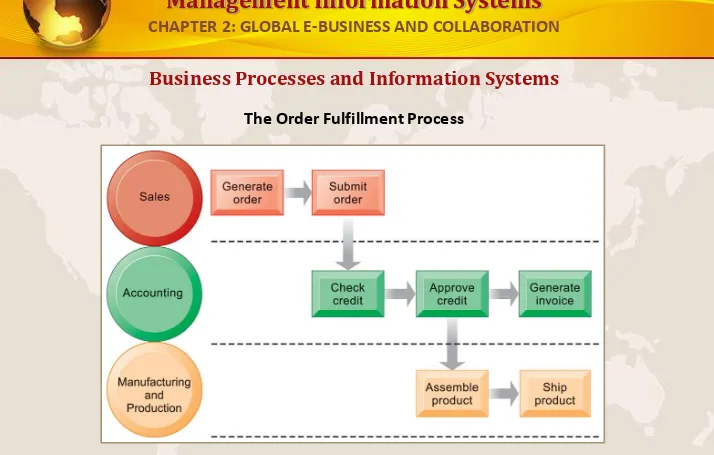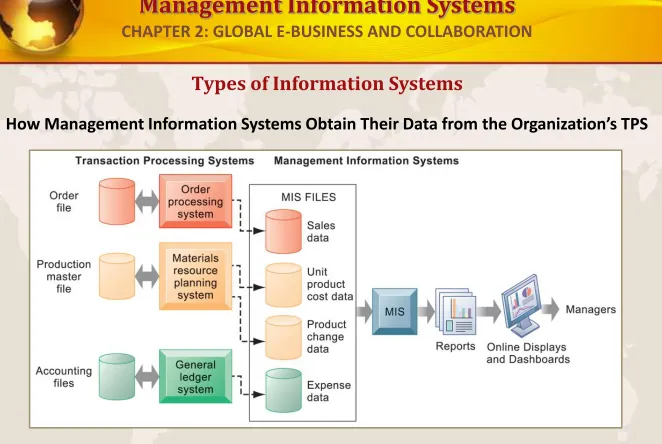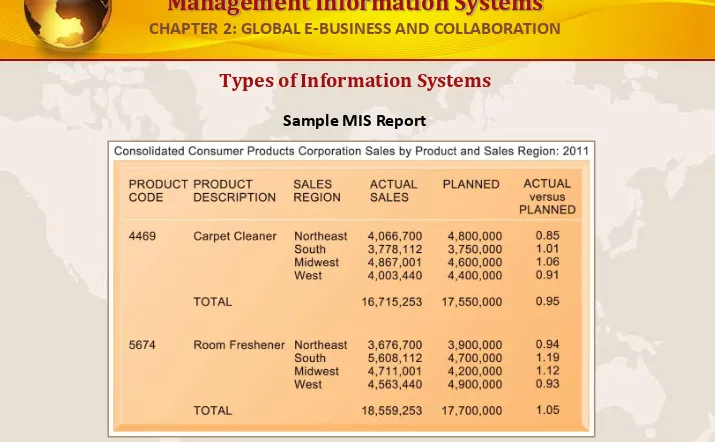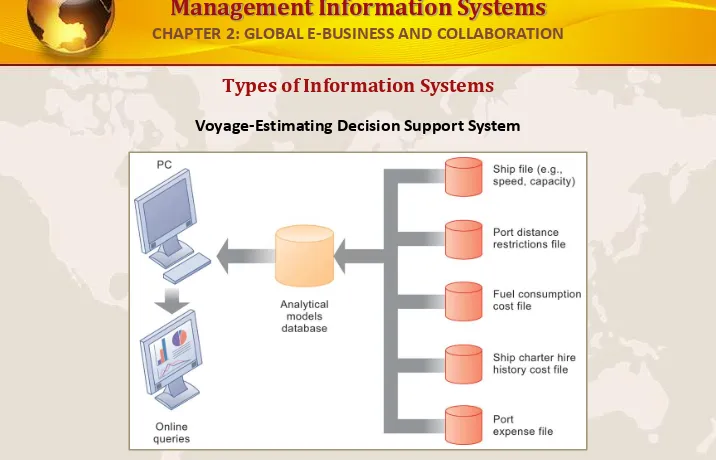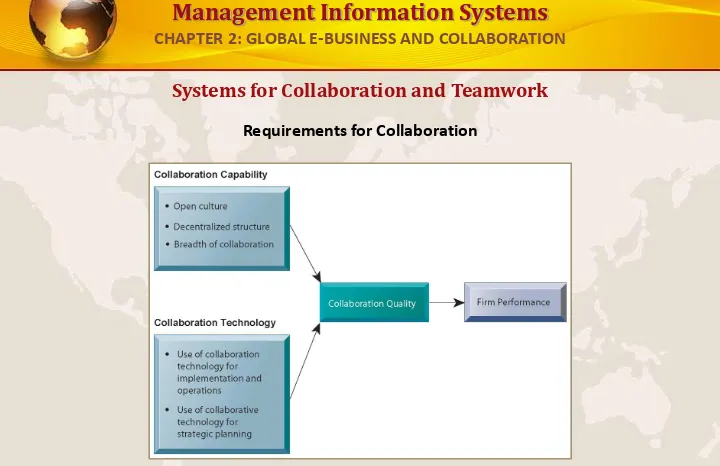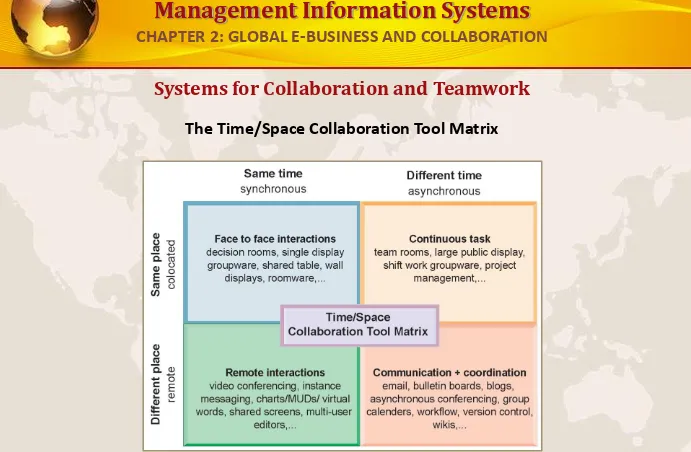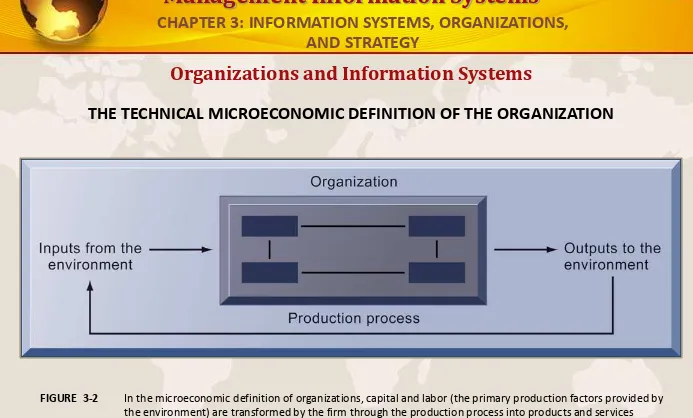Management Information Systems
MANAGING THE DIGITAL FIRM, 12THEDITION, GLOBAL EDITION
GLOBAL E-BUSINESS AND
COLLABORATION
Chapter 2
VIDEO CASES
Case 1: How FedEx Works: Enterprise Systems
Management Information Systems
Management Information Systems
CHAPTER 2: GLOBAL E-BUSINESS AND COLLABORATION
•
Define and describe business processes and their
relationship to information systems.
•
Evaluate the role played by systems serving the
various levels of management in a business and
their relationship to each other.
•
Explain how enterprise applications improve
organizational performance.
Management Information Systems
Management Information Systems
CHAPTER 2: GLOBAL E-BUSINESS AND COLLABORATION
•
Explain the importance of collaboration and
teamwork in business and how they are supported
by technology.
•
Assess the role of the information systems function
in a business.
Management Information Systems
Management Information Systems
CHAPTER 2: GLOBAL E-BUSINESS AND COLLABORATION
•
Problem:
Using IT to win the America’s Cup race
•
Solutions: New technology for physical engineering of
boat; sensor network to monitor conditions and data
analysis to improve the performance of sails and more.
•
IBM Oracle Database 11g data management software
provided real time analysis of boat’s sensor data.
•
Demonstrates IT’s role in fostering innovation and
improving performance.
•
Illustrates the benefits of using data analysis and IT to
improve products
Management Information Systems
Management Information Systems
CHAPTER 2: GLOBAL E-BUSINESS AND COLLABORATION
•
Business processes:
–
Workflows of material, information, knowledge
–
Sets of activities, steps
–
May be tied to functional area or be
cross-functional
•
Businesses: Can be seen as collection of
business processes
•
Business processes may be assets or
liabilities
Management Information Systems
Management Information Systems
CHAPTER 2: GLOBAL E-BUSINESS AND COLLABORATION
•
Examples of functional business processes
–
Manufacturing and production
•
Assembling the product
–
Sales and marketing
•
Identifying customers
–
Finance and accounting
•
Creating financial statements
–
Human resources
•
Hiring employees
Management Information Systems
CHAPTER 2: GLOBAL E-BUSINESS AND COLLABORATION
Business Processes and Information Systems
The Order Fulfillment Process
Fulfilling a customer order involves a complex set of steps that requires the close coordination of the sales,
Management Information Systems
Management Information Systems
CHAPTER 2: GLOBAL E-BUSINESS AND COLLABORATION
•
Information technology enhances business
processes in two main ways:
1. Increasing efficiency of existing processes
•
Automating steps that were manual
2. Enabling entirely new processes that are
capable of transforming the businesses
•
Change flow of information
•
Replace sequential steps with parallel steps
•
Eliminate delays in decision making
Management Information Systems
Management Information Systems
CHAPTER 2: GLOBAL E-BUSINESS AND COLLABORATION
•
Transaction processing systems
–
Perform and record daily routine transactions
necessary to conduct business
•
Examples: sales order entry, payroll, shipping
–
Allow managers to monitor status of operations
and relations with external environment
–
Serve operational levels
–
Serve predefined, structured goals and decision
making
Management Information Systems
CHAPTER 2: GLOBAL E-BUSINESS AND COLLABORATION
Types of Information Systems
A Payroll TPS
A TPS for payroll processing captures employee payment transaction data (such as a time card). System outputs include online and hard-copy reports for management and employee paychecks.
Management Information Systems
Management Information Systems
CHAPTER 2: GLOBAL E-BUSINESS AND COLLABORATION
•
Management information systems
–
Serve middle management
–
Provide reports on firm’s current
performance, based on data from TPS
–
Provide answers to routine questions with
predefined procedure for answering them
–
Typically have little analytic capability
Management Information Systems
CHAPTER 2: GLOBAL E-BUSINESS AND COLLABORATION
Types of Information Systems
How Management Information Systems Obtain Their Data from the Organization’s TPS
In the system illustrated by this diagram, three TPS supply summarized transaction data to the MIS reporting system at the end of the time period. Managers gain access to the organizational data through the MIS, which
Management Information Systems
CHAPTER 2: GLOBAL E-BUSINESS AND COLLABORATION
Types of Information Systems
Sample MIS Report
This report, showing summarized annual sales data, was produced by the MIS in Figure 2-3.
Management Information Systems
Management Information Systems
CHAPTER 2: GLOBAL E-BUSINESS AND COLLABORATION
•
Decision support systems
–
Serve middle management
–
Support non-routine decision making
•
Example: What is impact on production schedule if
December sales doubled?
–
Often use external information as well from TPS and
MIS
–
Model driven DSS
•
Voyage-estimating systems
–
Data driven DSS
•
Intrawest’s marketing analysis systems
Management Information Systems
CHAPTER 2: GLOBAL E-BUSINESS AND COLLABORATION
Types of Information Systems
Voyage-Estimating Decision Support System
This DSS operates on a powerful PC. It is used daily by managers who must develop bids on shipping contracts.
Management Information Systems
Management Information Systems
CHAPTER 2: GLOBAL E-BUSINESS AND COLLABORATION
•
Business intelligence
–
Class of software applications
–
Analyze current and historical data to find
patterns and trends and aid decision-making
–
Used in systems that support middle and
senior management
•
Data-driven DSS
•
Executive support systems (ESS)
Management Information Systems
Management Information Systems
CHAPTER 2: GLOBAL E-BUSINESS AND COLLABORATION
•
Executive support systems
–
Support senior management
–
Address non-routine decisions
•
Requiring judgment, evaluation, and insight
–
Incorporate data about external events (e.g. new tax
laws or competitors) as well as summarized
information from internal MIS and DSS
–
Example:
Digital dashboard with real-time view of
firm’s financial performance: working capital,
accounts receivable, accounts payable, cash flow, and
inventory
Management Information Systems
Management Information Systems
CHAPTER 2: GLOBAL E-BUSINESS AND COLLABORATION
•
Systems from a constituency
perspective
–
Transaction processing systems: supporting
operational level employees
–
Management information systems and
decision-support systems: supporting
managers
–
Executive support systems: supporting
executives
Management Information Systems
Management Information Systems
CHAPTER 2: GLOBAL E-BUSINESS AND COLLABORATION
•
Relationship of systems to one another
–
TPS:
Major source of data for other systems
–
ESS:
Recipient of data from lower-level
systems
–
Data may be exchanged between systems
–
In reality, most businesses’ systems are
only loosely integrated (but they are
getting better!)
Management Information Systems
Read the Interactive Session and discuss the following questions
Management Information Systems
Read the Interactive Session and discuss the following questions
CHAPTER 2: GLOBAL E-BUSINESS AND COLLABORATION
•
Describe RocketTheme’s business model and
business strategy. What challenges is it facing?
•
What systems have the company used or planned
to use to overcome these challenge? What types of
systems are they? What role will each play in
helping RocketTheme overcome these challenges?
•
What other types of system could help
RocketTheme overcome its challenges?
Types of Information Systems
Management Information Systems
Management Information Systems
CHAPTER 2: GLOBAL E-BUSINESS AND COLLABORATION
•
Enterprise applications
–
Systems for linking the enterprise
–
Span functional areas
–
Execute business processes across firm
–
Include all levels of management
–
Four major applications:
•
Enterprise systems
•
Supply chain management systems
•
Customer relationship management systems
•
Knowledge management systems
Management Information Systems
CHAPTER 2: GLOBAL E-BUSINESS AND COLLABORATION
Types of Information Systems
Enterprise Application Architecture
Enterprise applications automate processes that span multiple business functions and
organizational levels and may extend outside the organization.
Management Information Systems
Management Information Systems
CHAPTER 2: GLOBAL E-BUSINESS AND COLLABORATION
•
Enterprise systems
–
Collects data from different firm functions and stores
data in single central data repository
–
Resolves problem of fragmented, redundant data
sets and systems
–
Enable:
•
Coordination of daily activities
•
Efficient response to customer orders (production,
inventory)
•
Provide valuable information for improving
management decision making
Management Information Systems
Management Information Systems
CHAPTER 2: GLOBAL E-BUSINESS AND COLLABORATION
•
Supply chain management (SCM) systems
–
Manage firm’s relationships with suppliers
–
Share information about
•
Orders, production, inventory levels,
delivery of products and services
–
Goal:
•
Right amount of products to destination with
least amount of time and lowest cost
Management Information Systems
Management Information Systems
CHAPTER 2: GLOBAL E-BUSINESS AND COLLABORATION
•
Customer relationship management systems:
–
Provide information to coordinate all of the
business processes that deal with customers in
sales, marketing, and service to optimize
revenue, customer satisfaction, and customer
retention
–
Integrate firm’s customer
-related processes and
consolidate customer information from multiple
communication channels
Management Information Systems
Management Information Systems
CHAPTER 2: GLOBAL E-BUSINESS AND COLLABORATION
•
Knowledge management systems (KMS)
–
Support processes for acquiring, creating,
storing, distributing, applying, integrating
knowledge
•
How to create, produce, distribute products
and services
–
Collect internal knowledge and experience
within firm and make it available to employees
–
Link to external sources of knowledge
Management Information Systems
Management Information Systems
CHAPTER 2: GLOBAL E-BUSINESS AND COLLABORATION
•
Alternative tools that increase integration
and expedite the flow of information
–
Intranets:
•
Internal company Web sites accessible only by
employees
–
Extranets:
•
Company Web sites accessible externally only
to vendors and suppliers
•
Often used to coordinate supply chain
Management Information Systems
Management Information Systems
CHAPTER 2: GLOBAL E-BUSINESS AND COLLABORATION
•
E-business
–
Use of digital technology and Internet to drive major
business processes
•
E-commerce
–
Subset of e-business
–
Buying and selling goods and services through
Internet
•
E-government:
–
Using Internet technology to deliver information and
services to citizens, employees, and businesses
Management Information Systems
Management Information Systems
CHAPTER 2: GLOBAL E-BUSINESS AND COLLABORATION
•
Collaboration:
–
Short-lived or long-term
–
Informal or formal (teams)
•
Growing importance of collaboration:
–
Changing nature of work
–
Growth of professional work
– “interaction jobs”
–
Changing organization of the firm
–
Changing scope of the firm
–
Emphasis on innovation
–
Changing culture of work
Management Information Systems
Management Information Systems
CHAPTER 2: GLOBAL E-BUSINESS AND COLLABORATION
•
Business benefits of collaboration and teamwork
–
Investments in collaboration technology can produce
organizational improvements returning high ROI
–
Benefits:
•
Productivity
•
Quality
•
Innovation
•
Customer service
•
Financial performance
–
Profitability, sales, sales growth
Management Information Systems
CHAPTER 2: GLOBAL E-BUSINESS AND COLLABORATION
Systems for Collaboration and Teamwork
Requirements for Collaboration
Successful collaboration requires an appropriate organizational structure and culture, along with appropriate
Management Information Systems
Management Information Systems
CHAPTER 2: GLOBAL E-BUSINESS AND COLLABORATION
•
Building a collaborative culture and business
processes
–
“Command and control” organizations
•
No value placed on teamwork or lower-level
participation in decisions
–
Collaborative business culture
•
Senior managers rely on teams of employees
•
Policies, products, designs, processes, systems rely on
teams
•
Managers purpose is to build teams
Management Information Systems
Management Information Systems
CHAPTER 2: GLOBAL E-BUSINESS AND COLLABORATION
•
Technology for collaboration and teamwork
–
15 categories of collaborative software tools
Email and instant messaging White boarding
Collaborative writing Web presenting
Collaborative reviewing
Work scheduling
Event scheduling
Document sharing /wikis
File sharing
Mind mapping
Screen sharingLarge audience Webinars
Audio conferencing
Co-browsing
Video conferencing
Management Information Systems
Management Information Systems
CHAPTER 2: GLOBAL E-BUSINESS AND COLLABORATION
•
Technology for collaboration and teamwork (cont.)
–
Social Networking
–
Wikis
–
Virtual Worlds
–
Internet-Based Collaboration Environments
•
Virtual meeting systems (telepresence)
•
Google Apps/Google sites
•
Microsoft SharePoint
•
Lotus Notes
Management Information Systems
Read the Interactive Session and discuss the following questions
Management Information Systems
Read the Interactive Session and discuss the following questions
CHAPTER 2: GLOBAL E-BUSINESS AND COLLABORATION
•
What are the advantages of using
videoconferencing technologies? What are the
disadvantages?
•
What is telepresence and what sorts of companies
are best suited to use it as a communications tool?
•
What kinds of companies could benefit from using
videoconferencing? Are there any companies that
might not derive any benefits from this technology?
Systems for Collaboration and Teamwork
Management Information Systems
Management Information Systems
CHAPTER 2: GLOBAL E-BUSINESS AND COLLABORATION
•
Two dimensions of collaboration technologies
–
Space (or location)
–
remote or colocated
–
Time
–
synchronous or asynchronous
•
Six steps in evaluating software tools
1.
What are your firm’s collaboration challenges?
2. What kinds of solutions are available?
3.
Analyze available products’ cost and benefits
4. Evaluate security risks
5. Consult users for implementation and training issues
6. Evaluate product vendors
Management Information Systems
CHAPTER 2: GLOBAL E-BUSINESS AND COLLABORATION
Systems for Collaboration and Teamwork
The Time/Space Collaboration Tool Matrix
Collaboration technologies can be classified in terms of whether they support interactions at the same or
Management Information Systems
Management Information Systems
CHAPTER 2: GLOBAL E-BUSINESS AND COLLABORATION
•
Information systems department:
•
Formal organizational unit responsible for
information technology services
•
Often headed by chief information officer (CIO)
•
Other senior positions include chief security officer
(CSO), chief knowledge officer (CKO), chief privacy
officer (CPO)
•
Programmers
•
Systems analysts
•
Information systems managers
Management Information Systems
Management Information Systems
CHAPTER 2: GLOBAL E-BUSINESS AND COLLABORATION
•
End users
•
Representatives of other departments for whom
applications are developed
•
Increasing role in system design, development
•
IT Governance:
•
Strategies and policies for using IT in the organization
•
Decision rights
•
Accountability
•
Organization of information systems function
•
Centralized, decentralized, etc.
Management Information Systems
Management Information Systems
All rights reserved. No part of this publication may be reproduced, stored in a retrieval system, or transmitted, in any form or by any means, electronic, mechanical, photocopying, recording, or otherwise, without the
prior written permission of the publisher.
Printed in the United States of America.
Management Information Systems
MANAGING THE DIGITAL FIRM, 12THEDITION, GLOBAL EDITION
INFORMATION SYSTEMS,
ORGANIZATIONS, AND STRATEGY
Chapter 3
VIDEO CASES
Management Information Systems
•
Identify and describe important features of
organizations that managers need to know about in
order to build and use information systems
successfully.
•
Demonstrate how Porter’s competitive forces
model helps companies develop competitive
strategies using information systems.
•
Explain how the value chain and value web models
help businesses identify opportunities for strategic
information system applications.
Learning Objectives
Management Information Systems
•
Demonstrate how information systems help
businesses use synergies, core competencies, and
network-based strategies to achieve competitive
advantage.
•
Assess the challenges posed by strategic
information systems and management solutions.
Learning Objectives (cont.)
Management Information Systems
CHAPTER 3: INFORMATION SYSTEMS, ORGANIZATIONS, AND STRATEGY
•
Problem:
High-stakes competition in the wireless market
•
Solutions:
–
AT&T is marketing leading-edge devices
•
Has 43% of U.S. smartphone users, but poorer network
–
Verizon is investing in updating, expanding, and
improving network
•
Fewer smartphone customers, but most reliable in U.S.
•
Demonstrates IT’s central role in defining competitive
strategy
Management Information Systems
•
Information technology and organizations
influence one another
–
Complex relationship influenced by
organization’s
•
Structure
•
Business processes
•
Politics
•
Culture
•
Environment, and
•
Management decisions
Organizations and Information Systems
Management Information Systems
Organizations and Information Systems
THE TWO-WAY RELATIONSHIP BETWEEN
ORGANIZATIONS AND INFORMATION TECHNOLOGY
This complex two-way relationship is mediated by many factors, not the least of which are the decisions made—or not made—by managers. Other factors mediating the relationship include the organizational culture, structure, politics, business processes, and environment.
FIGURE 3-1
Management Information Systems
•
What is an organization?
–
Technical definition:
•
Stable, formal social structure that takes resources from
environment and processes them to produce outputs
•
A formal legal entity with internal rules and procedures,
as well as a social structure
–
Behavioral definition:
•
A collection of rights, privileges, obligations, and
responsibilities that is delicately balanced over a period
of time through conflict and conflict resolution
Organizations and Information Systems
Management Information Systems
Organizations and Information Systems
THE TECHNICAL MICROECONOMIC DEFINITION OF THE ORGANIZATION
In the microeconomic definition of organizations, capital and labor (the primary production factors provided by the environment) are transformed by the firm through the production process into products and services (outputs to the environment). The products and services are consumed by the environment, which supplies additional capital and labor as inputs in the feedback loop.
FIGURE 3-2
Management Information Systems
Organizations and Information Systems
THE BEHAVIORAL VIEW OF ORGANIZATIONS
The behavioral view of organizations emphasizes group relationships, values, and structures.
FIGURE 3-3
Management Information Systems
•
Features of organizations
•
Use of hierarchical structure
•
Accountability, authority in system of impartial
decision making
•
Adherence to principle of efficiency
•
Routines and business processes
•
Organizational politics, culture, environments
and structures
Organizations and Information Systems
Management Information Systems
•
Routines and business processes
•
Routines (standard operating procedures)
•
Precise rules, procedures, and practices
developed to cope with virtually all
expected situations
•
Business processes: Collections of routines
•
Business firm: Collection of business
processes
Organizations and Information Systems
Management Information Systems
Organizations and Information Systems
ROUTINES, BUSINESS
PROCESSES, AND FIRMS
All organizations are composed of individual routines and behaviors, a collection of which make up a business process. A collection of business
processes make up the
business firm. New information system applications require that individual routines and business processes change to achieve high levels of
organizational performance.
FIGURE 3-4
Management Information Systems
•
Organizational politics
•
Divergent viewpoints lead to
political struggle, competition,
and conflict
•
Political resistance greatly
hampers organizational change
Organizations and Information Systems
Management Information Systems
•
Organizational culture:
•
Encompasses set of assumptions that
define goal and product
•
What products the organization should produce
•
How and where it should be produced
•
For whom the products should be produced
•
May be powerful unifying force as well as
restraint on change
Organizations and Information Systems
Management Information Systems
•
Organizational environments:
•
Organizations and environments have a reciprocal
relationship
•
Organizations are open to, and dependent on, the
social and physical environment
•
Organizations can influence their environments
•
Environments generally change faster than
organizations
•
Information systems can be an instrument of
environmental scanning, act as a lens
Organizations and Information Systems
Management Information Systems
Organizations and Information Systems
ENVIRONMENTS AND ORGANIZATIONS HAVE A RECIPROCAL RELATIONSHIP
Environments shape what organizations can do, but organizations can influence their environments and decide to change environments altogether. Information technology plays a critical role in helping
organizations perceive environmental change and in helping organizations act on their environment.
FIGURE 3-5
Management Information Systems
•
Disruptive technologies
–
Technology that brings about sweeping change to
businesses, industries, markets
–
Examples: personal computers, word processing
software, the Internet, the PageRank algorithm
–
First movers and fast followers
•
First movers
–
inventors of disruptive
technologies
•
Fast followers
–
firms with the size and
resources to capitalize on that technology
Organizations and Information Systems
Management Information Systems
•
5 basic kinds of organizational structure
–
Entrepreneurial:
•
Small start-up business
–
Machine bureaucracy:
•
Midsize manufacturing firm
–
Divisionalized bureaucracy:
•
Fortune 500 firms
–
Professional bureaucracy:
•
Law firms, school systems, hospitals
–
Adhocracy:
•
Consulting firms
Organizations and Information Systems
Management Information Systems
•
Other organizational features
–
Goals
–
Constituencies
–
Leadership styles
–
Tasks
–
Surrounding environments
Organizations and Information Systems
Management Information Systems
•
Economic impacts
–
IT changes relative costs of capital and the costs of
information
–
Information systems technology is a factor of
production, like capital and labor
–
IT affects the cost and quality of information and
changes economics of information
•
Information technology helps firms contract in size
because it can reduce transaction costs (the cost of
participating in markets)
–
Outsourcing
How Information Systems Impact Organizations and Business Firms
Management Information Systems
•
Transaction cost theory
–
Firms seek to economize on transaction
costs (the costs of participating in markets)
•
Vertical integration, hiring more
employees, buying suppliers and
distributors
–
IT lowers market transaction costs for a
firm, making it worthwhile for firms to
transact with other firms rather than grow
the number of employees
How Information Systems Impact Organizations and Business Firms
Management Information Systems
How Information Systems Impact Organizations and Business Firms
THE TRANSACTION COST THEORY OF THE IMPACT OF INFORMATION TECHNOLOGY ON THE ORGANIZATION
Firms traditionally grew in size to reduce market transaction costs. IT potentially reduces the firms market transaction costs. This means firms can outsource work using the market, reduce their employee head count and still grow revenues, relying more on outsourcing firms and external contractors.
FIGURE 3-6
Management Information Systems
•
Agency theory:
–
Firm is nexus of contracts among self-interested
parties requiring supervision
–
Firms experience agency costs (the cost of
managing and supervising) which rise as firm
grows
–
IT can reduce agency costs, making it possible for
firms to grow without adding to the costs of
supervising, and without adding employees
How Information Systems Impact Organizations and Business Firms
Management Information Systems
How Information Systems Impact Organizations and Business Firms
THE AGENCY THEORY OF THE IMPACT OF INFORMATION TECHNOLOGY ON THE ORGANIZATION
FIGURE 3-7
Management Information Systems
•
Organizational and behavioral impacts
–
IT flattens organizations
•
Decision making pushed to lower levels
•
Fewer managers needed (IT enables faster
decision making and increases span of control)
–
Postindustrial organizations
•
Organizations flatten because in postindustrial
societies, authority increasingly relies on
knowledge and competence rather than formal
positions
How Information Systems Impact Organizations and Business Firms
Management Information Systems
How Information Systems Impact Organizations and Business Firms
FLATTENING ORGANIZATIONS
Information systems can reduce the number of levels in an organization by providing managers with information to supervise larger numbers of workers and by giving lower-level employees more decision-making authority.
FIGURE 3-8
Management Information Systems
•
Organizational resistance to change
–
Information systems become bound up in
organizational politics because they influence
access to a key resource
–
information
–
Information systems potentially change an
organization’s structure, culture, politics, and
work
–
Most common reason for failure of large projects
is due to organizational and political resistance to
change
How Information Systems Impact Organizations and Business Firms
Management Information Systems
How Information Systems Impact Organizations and Business Firms
ORGANIZATIONAL RESISTANCE AND THE MUTUALLY ADJUSTING RELATIONSHIP BETWEEN TECHNOLOGY AND THE ORGANIZATION
Implementing information systems has consequences for task arrangements, structures, and people. According to this model, to implement change, all four components must be changed simultaneously.
FIGURE 3-9
Management Information Systems
•
The Internet and organizations
–
The Internet increases the accessibility, storage,
and distribution of information and knowledge
for organizations
–
The Internet can greatly lower transaction and
agency costs
•
Example: Large firm delivers internal manuals
to employees via a corporate Web site, saving
millions of dollars in distribution costs
How Information Systems Impact Organizations and Business Firms
Management Information Systems
•
Central organizational factors to consider when
planning a new system:
–
Environment
–
Structure
•
Hierarchy, specialization, routines, business processes
–
Culture and politics
–
Type of organization and style of leadership
–
Main interest groups affected by system; attitudes of
end users
–
Tasks, decisions, and business processes the system
will assist
How Information Systems Impact Organizations and Business Firms
Management Information Systems
•
Why do some firms become leaders in their industry?
•
Michael Porter’s competitive forces model
–
Provides general view of firm, its competitors, and
environment
–
Five competitive forces shape fate of firm
1. Traditional competitors
2. New market entrants
3. Substitute products and services
4. Customers
5. Suppliers
Using Information Systems to Achieve Competitive Advantage
Management Information Systems
Using Information Systems to Achieve Competitive Advantage
PORTER’S COMPETITIVE FORCES MODEL
In Porter’s competitive forces model, the strategic position of the firm and its strategies are determined not only by competition with its traditional direct competitors but also by four other forces in the industry’s
environment: new market entrants, substitute products, customers, and suppliers.
FIGURE 3-10
Management Information Systems
•
Traditional competitors
–
All firms share market space with competitors who
are continuously devising new products, services,
efficiencies, switching costs
•
New market entrants
–
Some industries have high barriers to entry, e.g.
computer chip business
–
New companies have new equipment, younger
workers, but little brand recognition
Using Information Systems to Achieve Competitive Advantage
Management Information Systems
•
Substitute products and services
–
Substitutes customers might use if your prices
become too high, e.g. iTunes substitutes for CDs
•
Customers
–
Can customers easily switch to competitor’s
products? Can they force businesses to compete on
price alone in transparent marketplace?
•
Suppliers
–
Market power of suppliers when firm cannot raise
prices as fast as suppliers
Using Information Systems to Achieve Competitive Advantage
Management Information Systems
•
Four generic strategies for dealing
with competitive forces, enabled by
using IT
–
Low-cost leadership
–
Product differentiation
–
Focus on market niche
–
Strengthen customer and supplier
intimacy
Using Information Systems to Achieve Competitive Advantage
Management Information Systems
•
Low-cost leadership
–
Produce products and services at a lower price than
competitors while enhancing quality and level of
service
–
Examples: Wal-Mart
•
Product differentiation
–
Enable new products or services, greatly change
customer convenience and experience
–
Examples: Google, Nike, Apple
Using Information Systems to Achieve Competitive Advantage
Management Information Systems
•
Focus on market niche
–
Use information systems to enable a focused
strategy on a single market niche; specialize
–
Example: Hilton Hotels
•
Strengthen customer and supplier intimacy
–
Use information systems to develop strong ties and
loyalty with customers and suppliers; increase
switching costs
–
Example: Netflix, Amazon
Using Information Systems to Achieve Competitive Advantage
Management Information Systems
Read the Interactive Session and discuss the following questions
•
What competitive strategy are the credit card
companies pursuing? How do information systems
support that strategy?
•
What are the business benefits of analyzing customer
purchase data and constructing behavioral profiles?
•
Are these practices by credit card companies ethical?
Are they an invasion of privacy? Why or why not?
Using Information Systems to Achieve Competitive Advantage
HOW MUCH DO CREDIT CARD COMPANIES KNOW ABOUT YOU?
Management Information Systems
•
The Internet’s impact on competitive advantage
–
Transformation, destruction, threat to some
industries
•
E.g. travel agency, printed encyclopedia, newspaper
–
Competitive forces still at work, but rivalry more
intense
–
Universal standards allow new rivals, entrants to
market
–
New opportunities for building brands and loyal
customer bases
Using Information Systems to Achieve Competitive Advantage
Management Information Systems
Read the Interactive Session and discuss the following questions
•
Evaluate the impact of the iPad using Porter’s
competitive forces model.
•
What makes the iPad a disruptive technology? Who
are likely to be the winners and losers if the iPad
becomes a hit? Why?
•
What effects will the iPad have on the business
models of Apple, content creators, and distributors?
Using Information Systems to Achieve Competitive Advantage
IS THE IPAD A DISRUPTIVE TECHNOLOGY?
Management Information Systems
•
Business value chain model
–
Views firm as series of activities that add value to
products or services
–
Highlights activities where competitive strategies can
best be applied
•
Primary activities vs. support activities
–
At each stage, determine how information systems
can improve operational efficiency and improve
customer and supplier intimacy
–
Utilize benchmarking, industry best practices
Using Information Systems to Achieve Competitive Advantage
Management Information Systems
Using Information Systems to Achieve Competitive Advantage
THE VALUE CHAIN MODEL
This figure provides examples of systems for both primary and support activities of a firm and of its value partners that can add a margin of value to a
firm’s products or services.
FIGURE 3-11
Management Information Systems
•
Value web:
–
Collection of independent firms using
highly synchronized IT to coordinate
value chains to produce product or
service collectively
–
More customer driven, less linear
operation than traditional value chain
Using Information Systems to Achieve Competitive Advantage
Management Information Systems
Using Information Systems to Achieve Competitive Advantage
THE VALUE WEB
The value web is a networked system that can synchronize the value chains of business partners within an industry to respond rapidly to changes in supply and demand.
FIGURE 3-12
Management Information Systems
•
Information systems can improve overall
performance of business units by promoting
synergies and core competencies
–
Synergies
•
When output of some units used as inputs to
others, or organizations pool markets and
expertise
•
Example: merger of Bank of NY and JPMorgan
Chase
•
Purchase of YouTube by Google
Using Information Systems to Achieve Competitive Advantage
Management Information Systems
•
Core competencies
–
Activity for which firm is world-class
leader
–
Relies on knowledge, experience, and
sharing this across business units
–
Example: Procter & Gamble’s intranet
and directory of subject matter experts
Using Information Systems to Achieve Competitive Advantage
Management Information Systems
•
Network-based strategies
–
Take advantage of firm’s abilities to
network with each other
–
Include use of:
•
Network economics
•
Virtual company model
•
Business ecosystems
Using Information Systems to Achieve Competitive Advantage
Management Information Systems
•
Traditional economics: Law of diminishing returns
–
The more any given resource is applied to production, the
lower the marginal gain in output, until a point is reached
where the additional inputs produce no additional
outputs
•
Network economics:
–
Marginal cost of adding new participant almost zero, with
much greater marginal gain
–
Value of community grows with size
–
Value of software grows as installed customer base grows
Using Information Systems to Achieve Competitive Advantage
Management Information Systems
•
Virtual company strategy
–
Virtual company uses networks to ally with
other companies to create and distribute
products without being limited by traditional
organizational boundaries or physical
locations
–
E.g. Li & Fung manages production, shipment
of garments for major fashion companies,
outsourcing all work to over 7,500 suppliers
Using Information Systems to Achieve Competitive Advantage
Management Information Systems
•
Business ecosystems
–
Industry sets of firms providing related services and
products
•
Microsoft platform used by thousands of firms
•
Wal-
Mart’s order entry and inventory management
–
Keystone firms:
Dominate ecosystem and create
platform used by other firms
–
Niche firms:
Rely on platform developed by keystone
firm
–
Individual firms can consider how IT will help them
become profitable niche players in larger ecosystems
Using Information Systems to Achieve Competitive Advantage
Management Information Systems
Using Information Systems to Achieve Competitive Advantage
AN ECOSYSTEM STRATEGIC MODEL
The digital firm era requires a more dynamic view of the boundaries among industries, firms, customers, and suppliers, with competition occurring among industry sets in a business ecosystem. In the ecosystem model, multiple industries work together to deliver value to the customer. IT plays an important role in
FIGURE 3-13
Management Information Systems
•
Sustaining competitive advantage
–
Because competitors can retaliate and copy strategic
systems, competitive advantage is not always sustainable;
systems may become tools for survival
•
Performing strategic systems analysis
–
What is structure of industry?
–
What are value chains for this firm?
•
Managing strategic transitions
–
Adopting strategic systems requires changes in business
goals, relationships with customers and suppliers, and
business processes
Using Information Systems for Competitive Advantage: Management Issues
Management Information Systems
All rights reserved. No part of this publication may be reproduced, stored in a retrieval system, or transmitted, in any form or by any means, electronic, mechanical, photocopying, recording, or otherwise, without the prior written
permission of the publisher. Printed in the United States of America.
